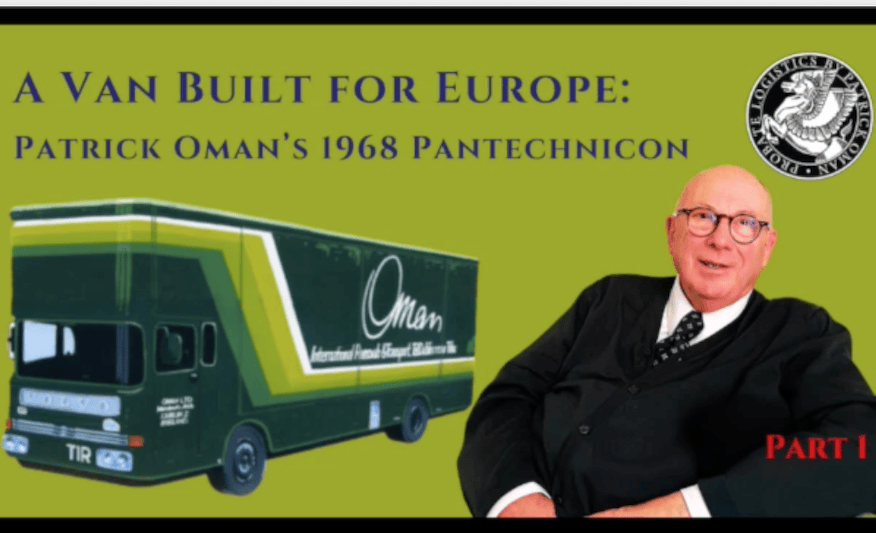Looking back over my career, one of the boldest moves I ever made began with a simple problem: I needed a bigger van. In the late 1960s, I was running a growing antiques and restoration business in Dublin. Clients started asking me to transport valuable pieces – not just locally, but across long distances. At that time, Córas Iompair Éireann (CIÉ) had a stranglehold on long-distance removals in Ireland, with government protection preventing new players from entering the field. Unless you were in business before the foundation of the Free State in 1922, you couldn’t get a license to operate beyond 30 miles. That didn’t sit well with me. I saw opportunity in this limitation – especially when B&I Line introduced the MV Munster ferry in 1968, linking Dublin and Liverpool. I realised that if I drove straight onto the ferry, I could bypass CIE’s 30-mile restriction and focus on international moves instead.
Still, I faced another obstacle – getting my hands on a van big enough to handle major international jobs. But the Irish government had also banned importing large commercial vehicles that might compete with CIÉ. There was, however, a loophole: you could import a bus. So, I found a solution in the form of a Volvo B58 bus chassis – a versatile, mid-engine model made in Sweden. I brought the chassis across the border via Irish Commercials, Volvo’s Northern Ireland agents. When it arrived at my office in Crown Alley, Dublin, I was like a man on a mission. I wrapped up warm, donned a crash helmet, stuck plywood in front of the cab for a bit of wind protection, and drove the bare chassis onto the ferry bound for Liverpool. From there, I made my way to Marsden coach builders in Warrington, where the real magic happened.
Within weeks, Marsden transformed that chassis into a stunning removals van – and I christened her Izabella. She was 11 metres long, could carry up to 60 cubic metres of goods and had five full-length loading doors along her sides. The design was brilliant. Because international jobs often involved smaller shipments – 10 to 20 cubic metres at a time – those side doors meant we could load and access multiple consignments without offloading everything. The entire body, including the cab, was built as a single unit. That’s what made Izabella a true Pantechnicon – a word dating back to 19th-century London, from the Greek pan (all) and techne (art). Back then, it referred to large wagons for transporting furniture and artworks. I never expected my Pantechnicon to stir such a fuss – but it did.
When Izabella made the cover of Removals & Storage magazine, she was hailed as the “biggest and best Pantechnicon ever built.” The British Association of Removers (B.A.R.) wasn’t pleased – mostly because I wasn’t a member. They called it a “TIR-plated pre-EU pirate ship.” But the controversy didn’t bother me much. Eventually, I joined the B.A.R. and went on to serve as President of both the Overseas Moving Network International (OMNI) and the European Relocation Association (EuRA). Over the years, Izabella and I completed countless jobs, many for the Department of Foreign Affairs, moving diplomats across Europe. Her last big job came with a household move to the Irish embassy in Rome. We loaded up in Rathgar and set off, but disaster struck crossing the Brenner Pass – Izabella’s engine gave out on the Italian side. The local garage’s repair estimate was astronomical. So, I got creative. I contacted the embassy, who linked me up with a local company – Fiasco & Quondamcarlo. The name felt a bit too fitting. They sent trucks to rescue our stranded load, delivered it to Rome, and kept the contract on track.
Izabella, though, remained stuck in that Alpine garage. For a long while, I didn’t know what to do with her. Then, at a B.A.R. conference in York, two men approached me – one Irish, one from Brighton. They’d heard about Izabella and wanted to buy her. I wasn’t too keen at first – I said I had a sentimental attachment. That, of course, raised their offer. But when I found out they were running charity convoys to Romania, hauling donated goods at cost, I was impressed. I told them I’d sell her – for £1. We shook hands and settled the deal across the hotel bar. They later retrieved her from Italy with a Bedford tractor unit and a dolly, hauled her back to Brighton, fitted a new engine, gave her a fresh coat of paint, and set her back on the road. Izabella, Ireland’s first and largest motorised Pantechnicon, spent her final years doing good – delivering aid to those who needed it most.

